
The 2023 Honda CR-V Hybrid will finally be offered in Canada, but only in the top trim level.Mark Richardson/The Globe and Mail
We’ve already reviewed the new CR-V – Honda’s best-selling vehicle in Canada and the best-selling SUV in the United States. (In Canada, it’s outsold by the Toyota RAV4, but not by much). We’ve also discussed the new CR-V Hybrid, but we’ve not driven it until now, when I finally took it up into the Southern California hills and wrung out its little motor for all it was worth.
I won’t clog this review with facts and figures, except to say the compact SUV is a little larger and a little more powerful than before. If you want the details, take a look at those two previous stories.
The fact is, drivers have waited a long time for the new hybrid CR-V. Honda was one of the first makers out the gate to electrify its fleet with hybrid engines in cars like the Civic and Insight, but they were dull and unpopular, and Toyota ate its lunch.
Time’s running short as gas nudges back up to $2 a litre and we move toward a ban on sales of new gasoline-powered vehicles by 2035. Toyota, Hyundai, Kia and Ford are way ahead with the hybrid SUVs that buyers now want and Honda has to catch up.
Here in the United States, there’s been a hybrid-powered CR-V since 2017, but Honda Canada never sold it north of the border. Honda said it was “a business decision,” because the compact SUV would be too costly.
This is, one hopes, all in the past with the new sixth-generation, made-in-Canada CR-V hybrid that is coming to showrooms any day now. The SUV is spacious, refined and quiet to drive. Similar to the regular 2023 CR-V, the windows are so large and well-designed that it’s like watching an Imax movie of the road.
Most important, the hybrid consumes less gas than the regular CR-V: Its official combined consumption is 6.4 litres per 100 kilometres, compared with 8.1 for its non-hybrid sibling. My own consumption in about 250 kilometres of “spirited” driving averaged eight.
It also makes more torque right from standstill, which is handy for passing and allows the CR-V to tow up to 1,000 pounds (454 kilograms). That doesn’t sound like much, but it means you can finally fix a trailer hitch to the back for attaching a bicycle rack, without voiding your warranty and upsetting your local dealer.
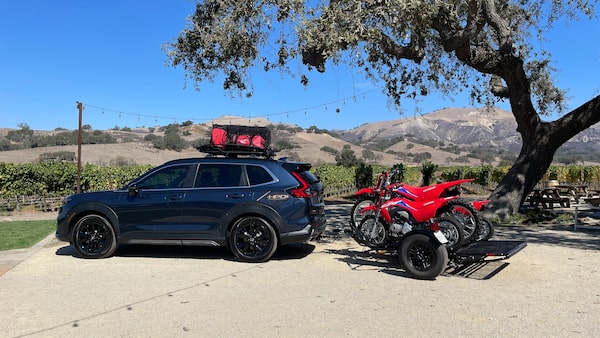
The 2023 Honda CR-V Hybrid can tow up to 1,000 pounds, which may not seem like much, but it means you can finally fix a trailer hitch to the back for attaching a bicycle rack, without voiding your warranty.Mark Richardson/The Globe and Mail
Here’s the rub: You’re not going to save any money because Honda will only put the hybrid engine in the most expensive trim level. It will cost $48,890, which means close to $58,000 once all the add-ons and taxes are paid. Compare that to $34,790 for the most basic two-wheel-drive version, and $41,490 for the well-equipped AWD Sport. If you want to save the planet by buying a hybrid, you’ll have to buy all the luxurious bells and whistles too.
Not in the United States, though. Americans get four different trim levels, and the hybrid-powered Sport is the second-least-expensive of them (as well as the top-end Touring Hybrid). In the States, you can forgo features like the hands-free powered tailgate and the satellite navigation and save more than US$6,000, but not in Canada. Ironic, because it’s made in Alliston, Ont., and the Canadian plant is the lead plant of the nine others around the world.
“We’ve decided to offer the CR-V in its most appointed form, with its most options available, in the highest possible trim with the hybrid, to start this process,” said John Bordignon, Honda Canada’s head of brand communications. “Our plan is to offer more trims and levels of hybrid engine technology in all of our core models moving forward.”
His American counterpart had another take on it.
“Typically, when we launch a new model, at least in the first year, we know we’re going to sell a much higher mix of top trim,” said Chris Martin, communications manager at American Honda. “Early adopter people are excited about the model. They want the best darn one they can get.
“Right now, we know we can’t build as many as we would want to, and we also know the proclivity for customers in the first year to aim toward the top trims anyway, so we’re aiming for that more-premium-level customer right now.”
Honda says it expects the hybrid CR-V to eventually account for about half of all its CR-V sales, though it doesn’t give a target date. Clearly, that will happen once the hybrid powertrain is offered in more affordable trim levels, and my guess is that will be sooner rather than later, probably in the 2024 models.
Tech specs
2023 Honda CR-V Hybrid
- Base price/as tested: $34,790/$48,890, plus $2,081 Freight and PDI
- Engine: Two-litre four cylinder, with two-motor hybrid; 204 horsepower, 247 lb-ft of torque
- Transmission/drive: Electronic continuously variable transmission/all-wheel drive
- Fuel consumption (litres per 100 kilometres): 6.0 city, 6.9 highway, 6.4 combined
- Alternatives: Toyota RAV4 Hybrid, Hyundai Tucson Hybrid, Ford Escape Hybrid, Kia Sportage Hybrid
Looks
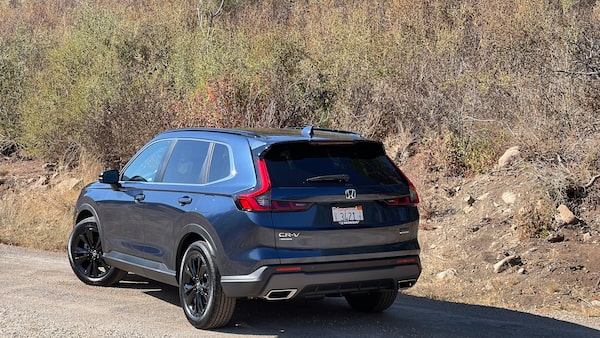
The 2023 Honda CR-V Hybrid has narrow LED lights front and back.Mark Richardson/The Globe and Mail
There’s little to distinguish the hybrid from the regular CR-V except for black roof rails and the badge on the rear. It’s a good-looking SUV, though, and modernized with narrow LED lights front and back.
Interior
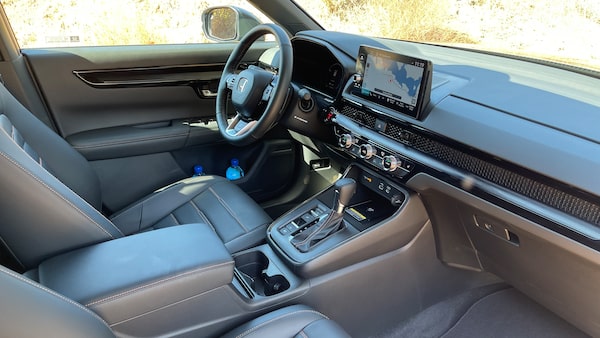
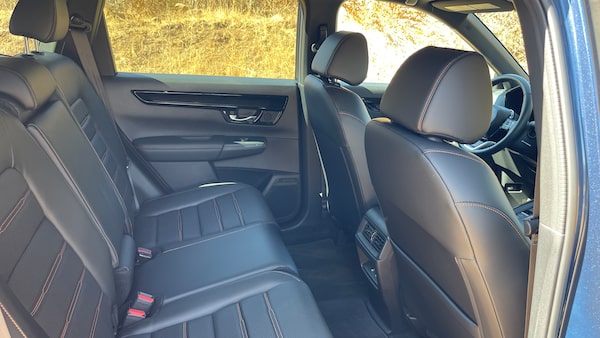
Above: The front seats and dash of the 2023 Honda CR-V Hybrid. Below: The back seats.Mark Richardson/The Globe and Mail
The seats are redesigned for greater comfort over long distances, and everything falls easily to hand. The cabin feels upscale and spacious.
Performance
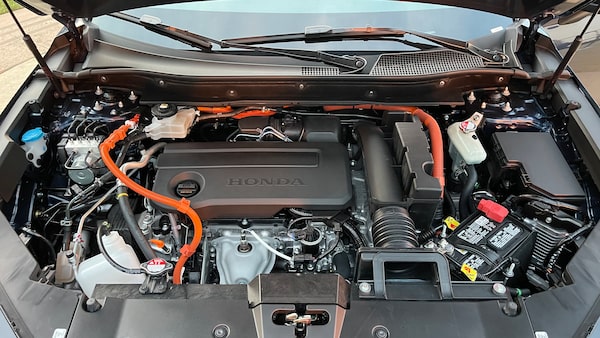
The engine of the 2023 Honda CR-V Hybrid.Mark Richardson/The Globe and Mail
There’s plenty of pep in the hybrid powertrain, with its two-litre engine and twin electric motors. It’s all sent to the wheels through what Honda calls an eCVT system, or electronic continuously variable transmission, which has steps to it that mimic the gears of a conventional automatic. “It’s not a CVT,” they say, except it still feels like one. Step on the throttle and everything whirs away at maximum revolutions, and the CR-V feels like it’s being pulled along by a wound-up elastic band. Some people don’t mind this, and appreciate the lighter weight and lower fuel consumption; others hate it. Me? I might get used to it, but it would take a while.
There’s also a “B” (for Brake) setting on the transmission lever that Honda says creates more regenerative power and allows for one-pedal operation, but it’s quite mild and you certainly still need to slow down with the brake pedal. You can increase the engine braking with paddles on the steering wheel, similar to other hybrids, which should emulate the feel of shifting down a gear for a corner, but it’s so mild that it really doesn’t.
Technology
The smart navigation system that’s only in the hybrid helps optimize fuel consumption by planning for hills and downward slopes it knows are approaching, which is clever. All the driver’s assistance features of other makers are offered and they work well. There’s also a new Snow mode among the four electronic drive modes that smooths out throttle inputs, but I really didn’t notice any difference compared to the Eco mode in regular driving; I kept it in Sport most of the time, which was much more fun.
Cargo
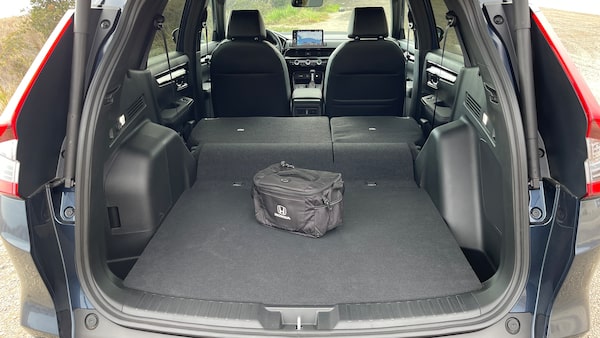
The Honda CR-V Hybrid has 1,028 litres of luggage space behind the rear seats, and 2,166 litres when those seats are folded flat.Mark Richardson/The Globe and Mail
There’s less luggage space in the hybrid CR-V than the regular edition because the additional battery takes up that room beneath the cargo floor. It allows for 1,028 litres of luggage behind the rear seats, and 2,166 litres when those seats are folded flat. That’s a bit more than the previous generation, though not much.
The verdict
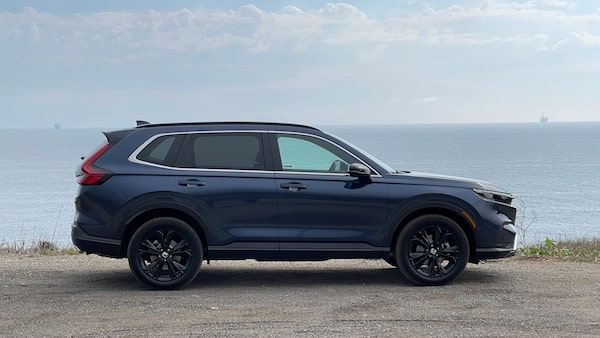
The 2023 Honda CR-V Hybrid offers better fuel consumption than its non-hybrid sibling by about 1.7 litres per 100 kilometres.Mark Richardson/The Globe and Mail
At last, Honda’s hybrid compact SUV is ready for the road. If you wait a year or so to let the rich people buy theirs first, it will become a lot more affordable.
The writer was a guest of the automaker. Content was not subject to approval.
Shopping for a new car? Check out the new Globe Drive Build and Price Tool to see the latest discounts, rebates and rates on new cars, trucks and SUVs. Click here to get your price.
 Mark Richardson
Mark Richardson